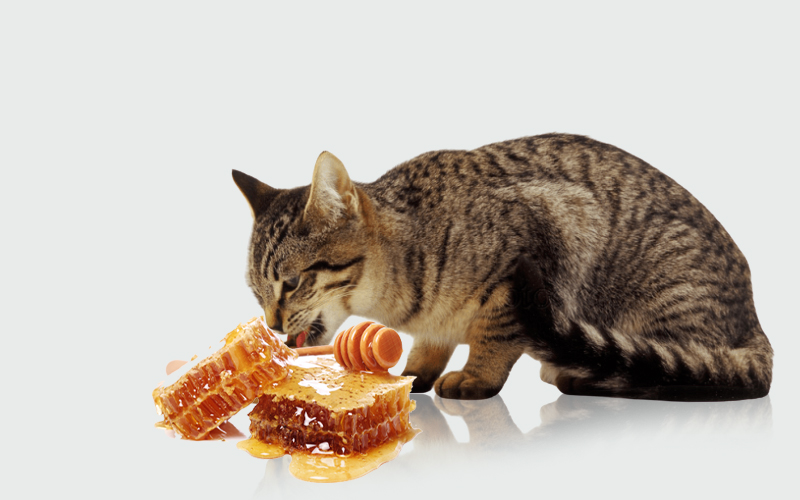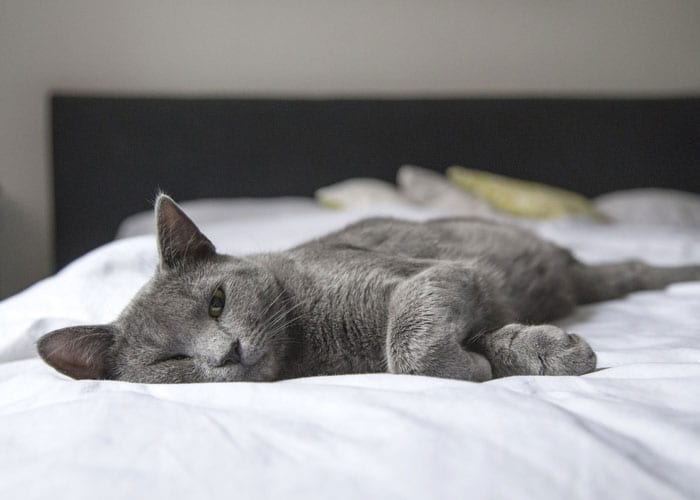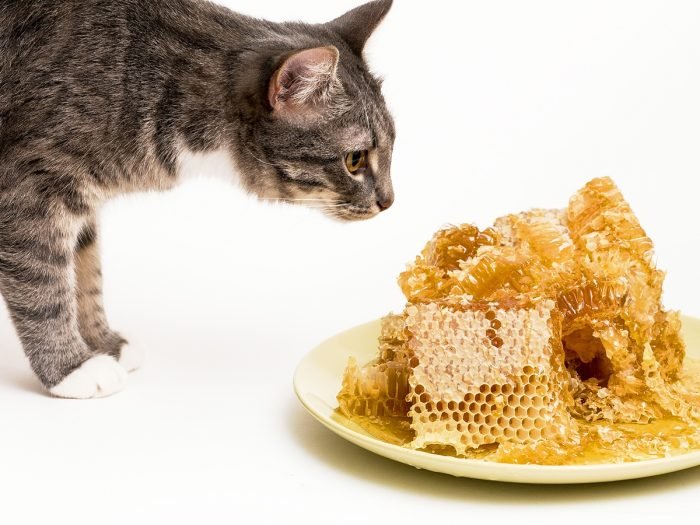Hypoglycemia is one of those things that pet parents don’t like to think about.
Although it is common with diabetic cats, it can happen to pretty much any feline.
From too much vomiting to loss of appetite to high insulin doses, there are many hypoglycemia triggers in cats.
Sadly, when blood sugar drops too low, your furbaby can suffer ill effects, one of which is death.
What can you give him to save his life?
That’s where honey comes in. This nature’s miracle cure is a savior when a kitty is not in a position to eat something to raise his blood sugar quickly.
Honey is a type of easy-to-digest fructose with additional benefits for the wellbeing of your kitty.
The problem is that too much can do more harm than good. So just how much honey should you give to a hypoglycemic cat?
We reveal the scoop in detail below.
Why Honey?

To know the reason sugar comes in handy for a hypoglycemic cat, you have to understand what the condition is in the first place.
As mentioned before, most cats that have hypoglycemia episodes have diabetes. A cat with diabetes is one whose body cannot control its blood sugar levels.
It could be either because his pancreas is unable to produce insulin or that the kitty doesn’t respond to his insulin.
Insulin injections are used to treat such cats. However, when the insulin goes beyond the threshold, blood sugar drops too low causing hypoglycemia.
Besides high insulin, hypoglycemia can be triggered by missed meals, intense physical activity, vomiting, and loss of appetite.
Honey is always recommended for hypoglycemic cats because it is easily absorbed by the body.
According to Medical News Today, this sweet bee syrup is easy to digest because it has enzymes that partially digest it.
Turns out that bees add these enzymes to honey during production. After harvesting nectar from flowers, a bee will store it in a stomach where it interacts with enzymes.
The bee then regurgitates it into his colleague’s mouth to be further digested. It will be passed from bee to bee until it becomes honey then stored in the honeycomb.
When your kitty’s blood sugar is too low, time is of the essence. The cat may not have too long before he passes out or dies.
If he’s already unconscious, real food will not help because he cannot eat it in the first place. Placing honey under his gums will raise his blood sugar quickly and ultimately save his life.
How Much Honey Is Okay For A Hypoglycemic Cat?

If your kitty is showing signs of hypoglycemia such as seizures, lethargy, restlessness, coma, twitching, weakness, or restlessness and is not alert, hand-feed honey until he can eat his normal food.
This rings true if he’s unconscious as well. Rub some honey on his gums until he is well again.
According to Cat Clinic of Cobb, a cat whose blood glucose is 50 or lower needs one tablespoon of honey. This is rubbed against the gums or placed under the tongue.
After rubbing the honey on the cat’s gums, give him one hour and test the blood sugar again. Hopefully, by this time, the kitty will have regained consciousness. If the levels are still too low, call the vet.
If you are successful and the kitty regains consciousness, start offering small amounts of food.
You want to give her food every 1-2 hours until the blood sugar has risen to the correct level.
If the cause of hypoglycemia is an insulin overdose, feed the cat until the overdose is counteracted.
Monitor the blood glucose for the next 12 hours just to be safe.
Keep in mind that honey is not a permanent fix to hypoglycemia. Granted, it raises blood sugar quickly but it won’t keep it high for too long.
Consider it as an emergency solution to low blood sugar. Once your kitty is alert and back to consciousness, be sure to give him real food to raise his blood sugar.
Warning

There are a few things to keep in mind when using honey for a glycemic cat. These include the following:
1. Don’t go overboard
Honey is relatively safe for cats as long as it is given in small quantities.
Unlike us, cats don’t assimilate foods rich in glucose and fructose very well – honey included.
The more the amount, the higher the distress in your kitty’s tummy. Anything more than one tablespoon does more harm than good.
2. Be careful around a seizing cat
If your kitty is having seizures, don’t squirt honey on him as he might choke and die in the process.
The best thing to do here would be to rush to the vet and get professional help.
3. Stick to quality, unprocessed honey
Raw or Manuka honey is the best source since it contains other properties that your kitty can benefit from.
Pasteurization or processing of honey kills some of the substances that give honey its antioxidant and antimicrobial properties.
4. Watch out for an overdose
Too much honey can affect a kitty by the way of stomach discomfort, vomiting, lethargy, and diarrhea.
If your cat exhibits any of the symptoms, rush him to the vet. It means that his body couldn’t handle the amount of honey in it.
Parting Thoughts
Honey is not your typical cat-friendly delicacy but when hypoglycemia hits, it can mean the difference between life and death for your kitty.
As long as you give not more than one tablespoon per day of raw or Manuka honey, your furball will be just fine.
As aforementioned, honey is only for emergencies. Seek help afterward or give real food to stabilize his blood sugar.

Hi! I am Eleanor Price. I started this website after my cat, Louie, almost died from a case of botulism (a type of food poisoning often caused by bacteria that grow on food items). Turned out that my cat’s diet was the problem. I have made it my duty to provide the best information and recommendations about everything cat lovers need to know about their felines’ health and wellbeing. My goal is to find the most informative content on anything feline-related and share it with fellow hardworking kitty lovers.

